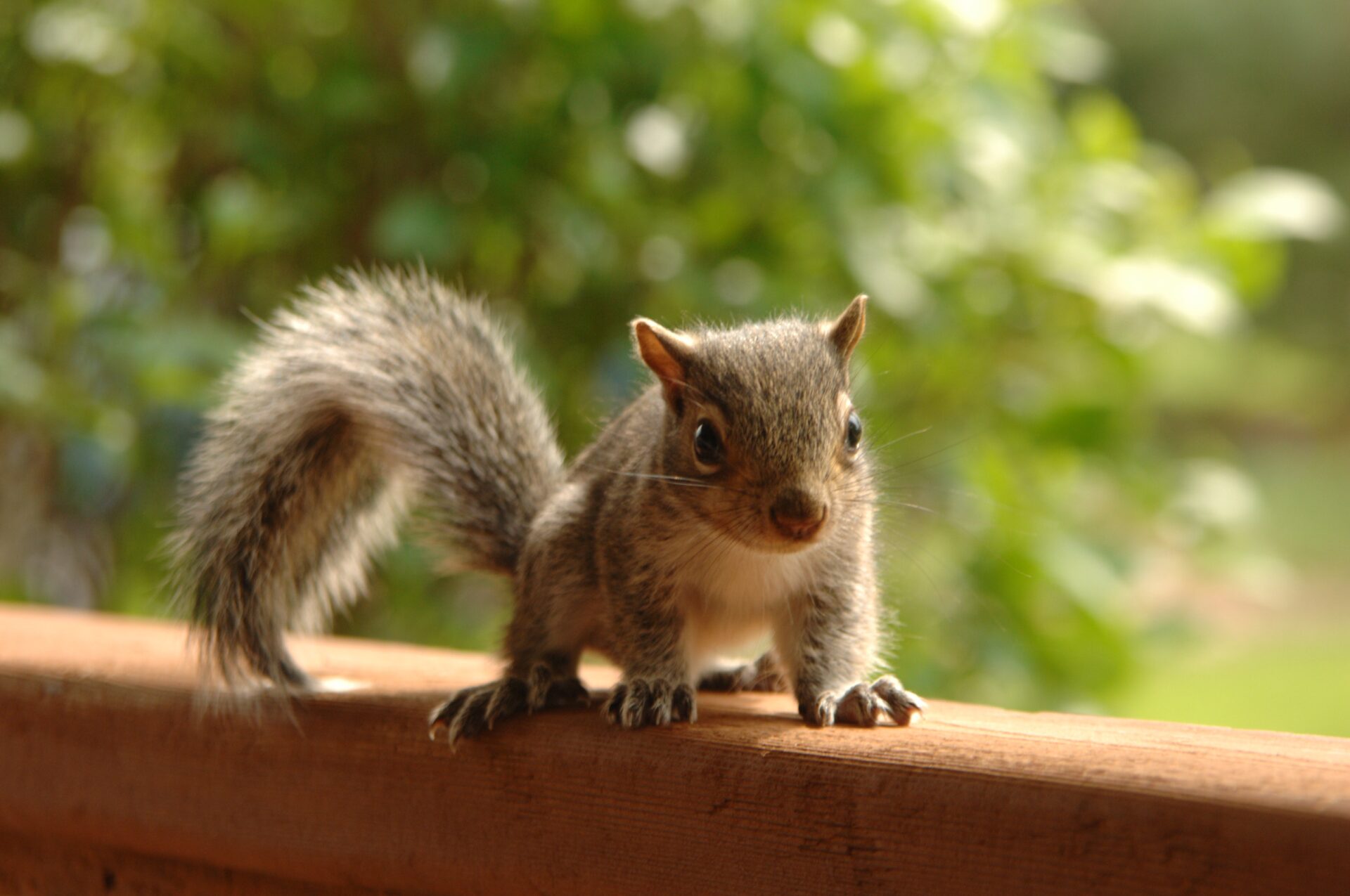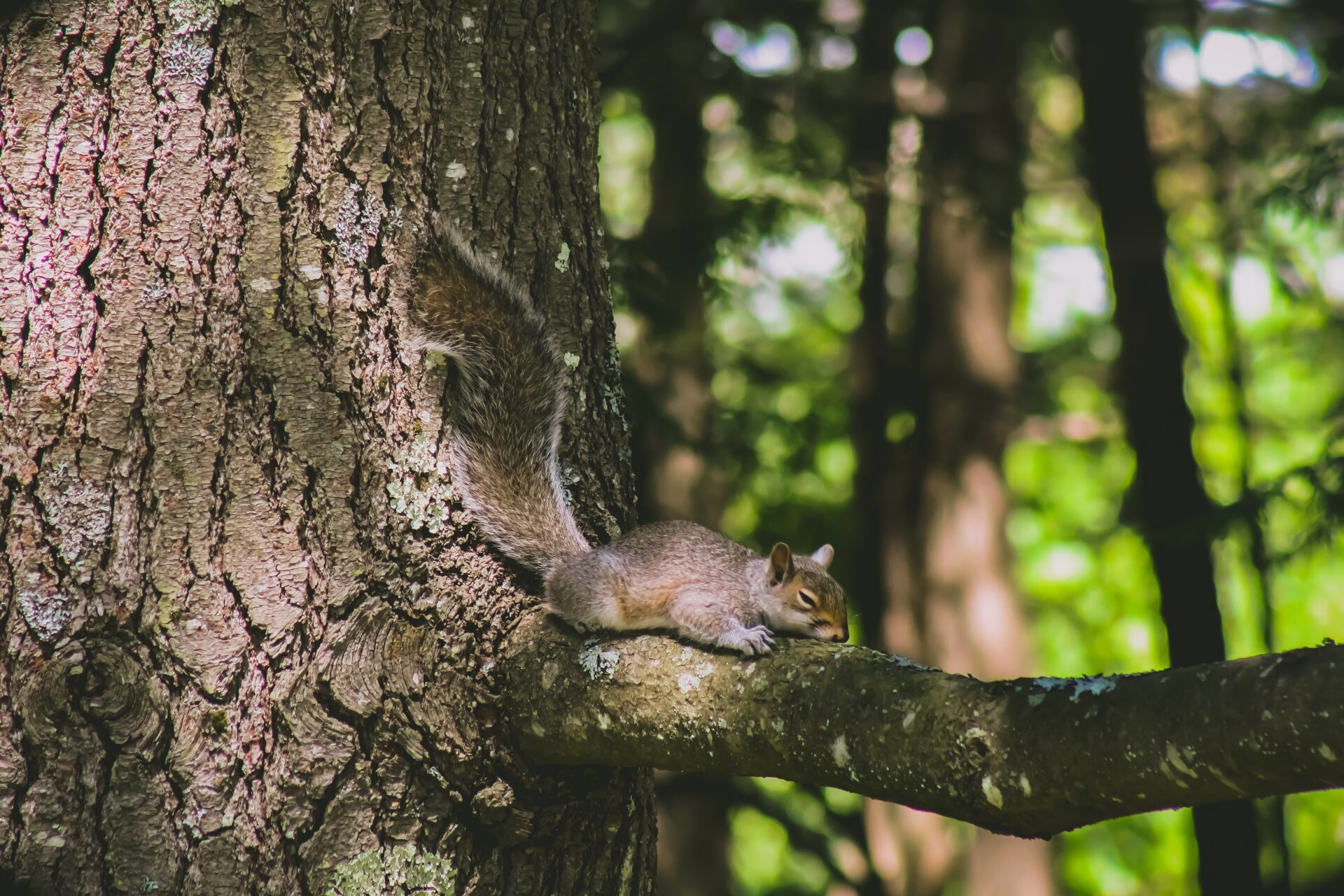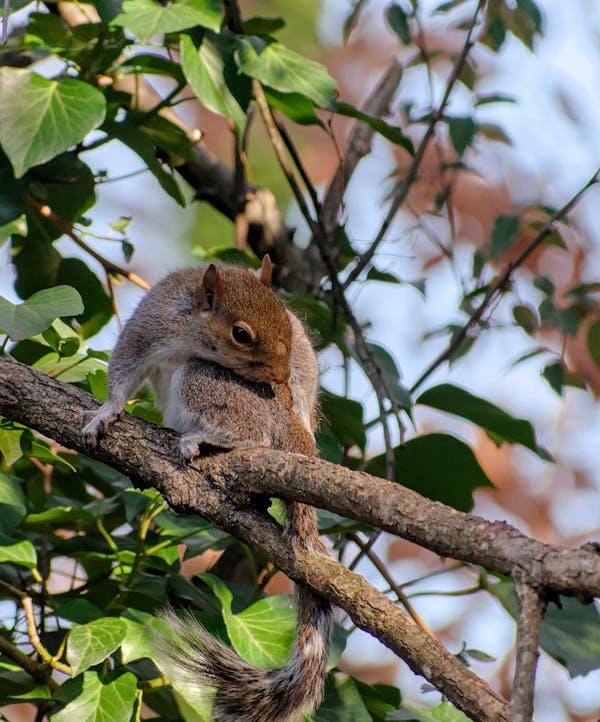Grey Squirrel
Introduction
The Eastern Gray Squirrel (Sciurus carolinensis) is a tree squirrel native to North America. It has a long evolutionary and ecological history that has shaped its widespread presence today.

Gray squirrels (Sciurus carolinensis) are medium-sized tree squirrels native to North America. They are highly adaptable and commonly found in forests, urban parks, and suburban areas. Here’s an overview of their biology:
Physical Characteristics
- Size: 9–12 inches (23–30 cm) in body length, with a tail length of 7–10 inches (18–25 cm).
- Weight: 14–21 ounces (400–600 g).
- Fur: Primarily gray with white underparts, though some may have brownish or black fur variations.
Reproduction
- Breeding Season: Late winter (January–February) and summer (June–July).
- Gestation: About 44 days.
- Litter Size: 2–4 young per litter.
- Development: Young are born blind and hairless; they leave the nest at about 10 weeks.
Behavior & Adaptations
- Activity: Diurnal (active during the day).
- Nesting: Build leaf nests (dreys) in trees or use tree cavities.
- Communication: Use vocalizations, tail flicking, and scent marking.
- Intelligence: Known for problem-solving abilities, especially in accessing food.
Lifespan & Predators
- Lifespan: Typically 6 years in the wild, but up to 12 years in captivity.
- Predators: Hawks, owls, foxes, snakes, and domestic pets.
Ecological Impact
- Help in seed dispersal by burying nuts.
- Can become invasive in non-native areas, outcompeting native red squirrels in Europe.
The gray squirrel (Sciurus carolinensis), commonly found in North America, has a well-defined life cycle consisting of several stages:
1. Birth & Early Development (0-12 weeks)
- Gray squirrels are born blind, hairless, and helpless in a nest (called a drey).
- Litters typically have 2-4 young.
- Their eyes open at about 4 weeks, and fur begins to develop.
- By 6-7 weeks, they start venturing out of the nest under their mother’s supervision.
2. Juvenile Stage (3-6 months)
- At around 10-12 weeks, they are weaned and begin foraging on their own.
- Young squirrels stay near their mother’s territory until they are fully independent.
- They practice climbing, jumping, and gathering food.
3. Subadult Stage (6 months – 1 year)
- They become more independent and establish their own home ranges.
- At around 9-11 months, they reach sexual maturity.
- If food is scarce, some may not breed until their second year.
4. Adulthood & Reproduction (1-6 years)
- Gray squirrels can live up to 6 years in the wild (longer in captivity).
- They have two breeding seasons per year:
- Late winter (December – February)
- Summer (May – July)
- Females may have 1-2 litters per year, each with 2-4 babies.
- Mating involves competitive chases among males.
5. Old Age & Death (6+ years)
- In the wild, many squirrels fall prey to predators (hawks, foxes, snakes, and domestic pets) or accidents.
- The oldest recorded wild gray squirrel lived to about 12 years.
- In captivity, they can live over 20 years.
Throughout their lives, gray squirrels play a crucial role in forest ecosystems by dispersing seeds and aerating the soil.
Diet:
Gray squirrels have an omnivorous diet, meaning they eat both plant and animal matter. Their diet mainly consists of:
Primary Foods:
- Nuts: Acorns, walnuts, hickory nuts, beechnuts, pecans
- Seeds: Sunflower seeds, pine seeds, maple seeds
- Fruits & Berries: Apples, berries, cherries, grapes
- Vegetables: Corn, mushrooms, squash, buds
Other Food Sources:
- Tree Bark & Twigs: Especially in winter when food is scarce
- Fungi: Such as mushrooms and truffles
- Flowers & Buds: Especially in spring
- Insects & Small Animals: Caterpillars, bird eggs, baby birds, and even small rodents on occasion
Human Food & Scraps:
- They often scavenge bird feeders, garbage, and leftovers from humans.
Gray squirrels hoard food by burying nuts and seeds in various locations for later retrieval, a behavior called scatter hoarding. This helps them survive harsh winters when food is scarce.
Habitat and Importance

Habitat
The Eastern Gray Squirrel is a tree-dwelling rodent native to North America. It thrives in a variety of habitats, including:
- Deciduous and Mixed Forests – Prefers oak, hickory, beech, and maple trees, which provide food and shelter.
- Urban and Suburban Areas – Common in city parks, neighborhoods, and gardens where trees and food sources are abundant.
- Woodlands and River Edges – Often found in forested areas near water sources.
These squirrels build nests called dreys, made of twigs and leaves, in tree branches or tree cavities.
Importance
- Ecological Role
- Seed Dispersers – Bury nuts and seeds, many of which are forgotten and grow into new trees, aiding forest regeneration.
- Prey Species – Serve as a food source for predators like hawks, owls, foxes, and snakes.
- Nutrient Cycling – Contribute to soil health by decomposing organic matter.
- Human and Environmental Impact
- Biodiversity Support – Help maintain healthy forest ecosystems.
- Research Subjects – Used in studies on behavior, intelligence, and disease transmission.
- Urban Adaptation – Help scientists understand how wildlife adapts to human-altered landscapes.
- Economic and Cultural Significance
- Hunting and Wildlife Observation – Valued in recreational hunting and nature watching.
- Pest Control Concerns – Can damage crops, gardens, and infrastructure by chewing wires and invading attics.
Despite their sometimes problematic interactions with humans, Eastern Gray Squirrels play a vital role in maintaining balanced ecosystems.
Origins & Conservation

Origins and Evolution
The Eastern Gray Squirrel belongs to the Sciuridae family, which includes tree squirrels, ground squirrels, chipmunks, and marmots. Fossil evidence suggests that squirrels evolved around 35-40 million years ago in North America. The Eastern Gray Squirrel itself likely evolved during the Pleistocene Epoch (about 2.6 million to 11,700 years ago).
Natural Habitat and Expansion
Originally, these squirrels were primarily found in the dense hardwood forests of the eastern United States and parts of Canada, particularly in areas rich in oak, hickory, and walnut trees. Their natural range includes:
- The eastern and central U.S. (from Florida to the Great Lakes)
- Southeastern Canada
- Some parts of the Midwest and Southern U.S.
With the decline of old-growth forests and urbanization, the gray squirrel adapted well to suburban and urban environments, where it continues to thrive.
Introduction to Other Regions
Humans have introduced the Eastern Gray Squirrel to many places outside its native range:
- United Kingdom and Ireland (1870s–1900s): The gray squirrel was introduced from North America and has since outcompeted the native red squirrel (Sciurus vulgaris), largely due to its adaptability and ability to carry the squirrelpox virus, which is lethal to red squirrels.
- Italy (1940s): Introductions have led to concerns about its spread into other European countries.
- South Africa, Australia, and Western U.S.: Limited introductions, though it has not spread as aggressively as in the UK.
Impact and Conservation
- Ecological Role: The gray squirrel plays a vital role in forest regeneration by burying acorns and nuts, inadvertently aiding tree growth.
- Invasive Status: In places like the UK, its dominance over the red squirrel has led to efforts to control its population.
- Hunting and Fur Trade: Historically, the gray squirrel was hunted for its fur and meat, particularly in the 18th and 19th centuries.
Modern Adaptation
Today, the Eastern Gray Squirrel continues to thrive in both wild and urban environments. Its intelligence, adaptability, and ability to find food in diverse settings make it one of the most successful small mammals in North America and beyond.
Proper Identification
Gray squirrels can be identified based on their physical characteristics, behavior, and habitat. Here’s how to distinguish them from other squirrels:
1. Physical Characteristics
- Fur Color: Mostly gray with a mix of white and brown. Some may have black or white variations, but the typical coloration is gray.
- Size: Larger than most other tree squirrels, typically 16–21 inches long, including their bushy tail.
- Belly Color: White or light-colored underside, contrasting with their grayish-brown back.
- Ears: Medium-sized and not tufted (unlike red squirrels, which have ear tufts in winter).
- Tail: Large, bushy, and covered in gray and white fur.
2. Comparison with Other Squirrels
- Red Squirrels (Tamiasciurus hudsonicus)
- Smaller (11–14 inches long)
- Reddish-brown fur with a white belly
- Often seen being more aggressive and vocal
- Prefer coniferous forests
- Fox Squirrels (Sciurus niger)
- Larger than gray squirrels (18–28 inches long)
- More orange-brown or rusty-colored, with a reddish belly
- Found in open woodlands and parks
- Flying Squirrels (Glaucomys spp.)
- Much smaller (10–12 inches long)
- Large, dark eyes and a flap of skin between front and back legs for gliding
- Nocturnal, rarely seen during the day
3. Behavior and Habitat
- Habitat: Found in both urban and forested areas, often in deciduous woodlands, parks, and backyards.
- Behavior: Diurnal (active during the day), frequently seen climbing trees, burying food, or raiding bird feeders.
- Sounds: They make chattering noises and can flick their tails aggressively when alarmed.
Identifying Squirrel damage
Gray squirrels can cause a variety of problems, particularly in urban, suburban, and rural areas. Some of the most common types of damage they cause include:
1. Property Damage
- Gnawing on Structures: They chew on wood, plastic, and even metal to wear down their constantly growing teeth. This can damage siding, decks, and outdoor furniture.
- Wiring and Electrical Damage: They chew through electrical wiring, which can create fire hazards in homes and buildings.
- Attic and Roof Damage: Squirrels can find their way into attics by gnawing through vents, shingles, and soffits, leading to costly repairs.
2. Garden and Crop Damage
- Eating Fruits, Vegetables, and Nuts: They raid gardens and orchards, consuming or damaging crops like tomatoes, apples, corn, and nuts.
- Digging up Bulbs and Plants: Squirrels dig in gardens and flower beds to bury or retrieve food, which can destroy plants and disrupt landscaping.
- Stripping Bark from Trees: They gnaw bark off young trees, which can weaken or kill the tree.
3. Bird Feeder and Wildlife Issues
- Raiding Bird Feeders: They consume large amounts of birdseed, often damaging feeders in the process.
- Competing with Native Wildlife: In some areas, gray squirrels outcompete native red squirrels and other wildlife for food and habitat.
4. Health and Safety Risks
- Carrying Parasites and Diseases: While not highly dangerous to humans, they can carry ticks, fleas, and diseases such as leptospirosis or squirrel pox.
- Aggressive Behavior: Although rare, squirrels can bite if they feel cornered or threatened.
Diseases
There are several diseases that can be transmitted between squirrels and humans, though direct transmission is relatively rare. Here are some of the most common diseases associated with squirrels:
Diseases That Squirrels Can Transmit to Humans
- Rabies – Rare in squirrels, but possible through bites or scratches. Symptoms in humans include fever, confusion, and paralysis.
- Leptospirosis – A bacterial disease spread through urine-contaminated water. It can cause flu-like symptoms, liver damage, and kidney failure.
- Salmonellosis – Squirrels can carry Salmonella bacteria in their feces, which can lead to food poisoning if ingested.
- Lyme Disease – Squirrels can carry ticks infected with Borrelia burgdorferi, the bacteria responsible for Lyme disease. Symptoms include fever, rash, and joint pain.
- Tularemia – Caused by Francisella tularensis, tularemia is transmitted through direct contact with an infected squirrel or tick bites. It can lead to fever, skin ulcers, and pneumonia.
- Ringworm – A fungal infection that squirrels can spread through direct contact, causing itchy, red, ring-shaped rashes on human skin.
Diseases That Affect Both Squirrels and Humans
- Plague – Yersinia pestis, the bacteria that cause the plague, can be carried by fleas on squirrels and transmitted to humans through flea bites.
- Roundworm (Baylisascaris procyonis) – This parasite, found in squirrel feces, can infect humans if ingested, leading to serious neurological symptoms.
Preventing Transmission
- Avoid direct contact with wild squirrels, especially if they appear sick.
- Do not feed or handle squirrels.
- Wear gloves if cleaning areas contaminated by squirrels.
- Keep pets protected from fleas and ticks.
- Wash hands thoroughly after outdoor activities.
Diseases can affect squirrels in several ways, impacting their health, behavior, and survival. Some common diseases that affect squirrels include:
1. Squirrel Pox (Fibromatosis)
- Caused by a virus that creates large, tumor-like growths on the skin.
- Can lead to difficulty eating, moving, or escaping predators.
- Often fatal in red squirrels but gray squirrels have some resistance.
2. Rabies
- Rare in squirrels but can cause aggression, confusion, and paralysis.
- Not a major concern for humans as transmission from squirrels is very uncommon.
3. Leptospirosis
- A bacterial disease that can spread through urine-contaminated water.
- Can cause fever, lethargy, and organ damage.
- May also pose a risk to humans and pets.
4. Lyme Disease (via Ticks)
- Squirrels can carry ticks that spread Lyme disease.
- Does not usually affect the squirrel itself but can be a risk to humans and other animals.
5. Coccidiosis
- A parasitic infection affecting the intestines, leading to diarrhea, weakness, and dehydration.
- Common in young or stressed squirrels.
6. Mange (Caused by Mites)
- Leads to hair loss, scaly skin, and irritation.
- Can make squirrels weak and more vulnerable to predators and harsh weather.
7. Tularemia
- A bacterial infection that causes fever, ulcers, and swollen lymph nodes.
- Can spread to humans through handling infected animals or being bitten by infected insects.
Effects on Squirrel Populations
- Diseases can significantly reduce squirrel numbers, especially in small or isolated populations.
- Sick squirrels may behave sluggishly, making them more susceptible to predators.
- Some diseases, like squirrel pox, can lead to competition shifts between species (e.g., red vs. gray squirrels).